17 Section 2-2
2.2. Food, Drink, and Family Members
In Chapter 1, you learned most vocabulary relating to the family. Below are more family member vocabulary words.

Here are a few new adjectives to describe these and other family members.
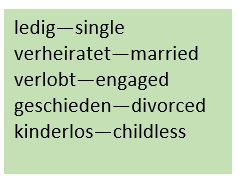
In Chapter 1, you also learned that der Mann is “the man” and die Frau is “the woman.” Both of these words also have a second definition.
der Mann—the husband (or der Ehemann)
die Frau—the wife (or die Ehefrau)
You may be wondering how to know the difference between them. If you use a possessive adjective with these words, they usually mean “husband” and “wife.” Compare.
Mein Mann spielt Golf. (My husband plays golf.)
Der Mann spielt Golf. (The man plays golf.)
Seine Frau spielt Klavier. (His wife plays piano.)
Die Frau spielt Klavier. (The woman plays piano.)
EXTRA PRACTICE: Click on Germanzone.org’s online exercises to review the family members from Chapter 1 and practice the new family member vocabulary from this chapter.
- https://www.germanzone.org/die-familie-1-der-familienstammbaum/.
- https://www.germanzone.org/die-familie-2-der-familienstammbaum/.
- https://www.germanzone.org/die-familie-3/.
In Chapter 1, you also learned about possessive adjectives.
|
Singular |
Plural |
|
mein/meine—my |
unser/unsere—our |
|
dein/deine—your (informal) |
euer/eure—y’alls (you guys’) |
|
sein/seine—his sein/seine—its ihr/ihre—her |
ihr/ihre—their Ihr/Ihre—your (polite) |
EXTRA PRACTICE: Click on Germanzone.org’s family tree exercise to practice new vocabulary words and to review possessive adjectives.
Ex. A: Was macht Ihre Familie gern? Using possessive adjectives (see chart above) and family members, tell what everyone in your family likes to do. Write at least 6-8 sentences.
Beispiel: Meine Mutter kocht gern. Mein Vater kocht nicht gern.
Video. Watch Coffeebreak German’s video to hear Germans talking about their families. The first half is without subtitles, and the second half repeats with subtitles.
We can take it one step further and talk about everyone’s favorite drinks.
Beispiel: Ich trinke gern Cola. Meine Schwester trinkt gern Sprite.

Ex. B: Was trinken Sie gern? Was trinken Sie nicht gern?
Ich trinke gern ___________. Ich trinke nicht gern ___________.
(I like to drink ___________. I do not like to drink ___________.)
Was trinkt ihre Familie gern? Nicht gern?
Mein Cousin trinkt gern _________. Er trinkt nicht gern ________.
Meine Nichte trinkt gern ________. Sie trinkt nicht gern ________.
…usw
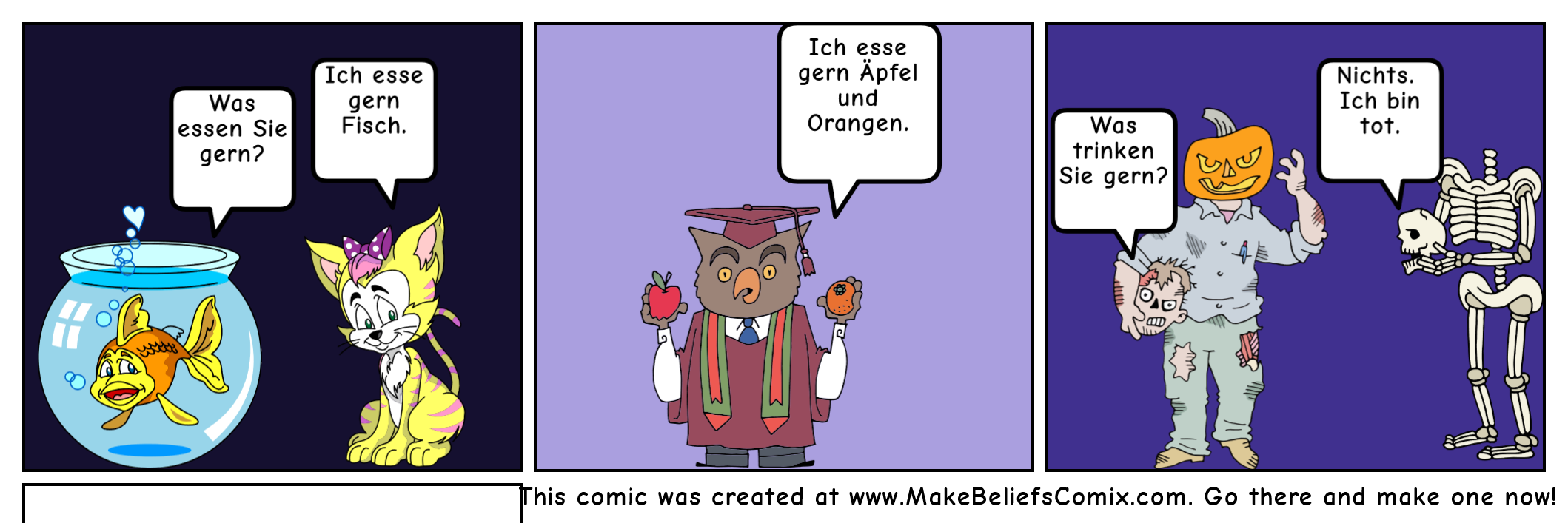
Ex. C: Was essen Sie gern? Was essen Sie nicht gern? (If you don’t know all of these foods yet, go here to see pictures of them: VISUAL LEARNER DICTIONARY)
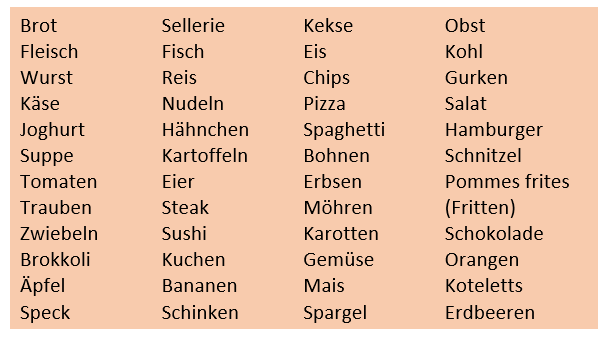
Ich esse gern ________. Ich esse nicht gern _________.
(I like to eat _________. I do not like to eat _________.)
QUICK LISTENING: Listen to Mathilda (AudioLingua) talk about what she likes and doesn’t like to eat and drink. Make a list of the foods and drinks you hear.
- Essen
- Getränke
Finally, watch Deutsch im Blick‘s video of a fruit and veggie seller talking about her wares. You will hear several new food words from this section and prices. You won’t understand everything; just listen for key words!
(Used with permission from The University of Texas at Austin | coerll.utexas.edu.)
MORE FOOD: Check out Claudia Kost’s and Crystal Sawatzky’s (University of Alberta) activity for more examples of food:
Ex. D: Listening Practice. Listen to the following audio clips about what Anke likes to eat and drink and fill in the missing blanks. (Audio courtesy of AudioLingua user Anke.)
Ex. E: Beschreiben Sie Ihr Essen! Using the adjectives, express your opinion on the following foods in a complete sentence.

Beispiel: 
→Ich finde Brot sehr lecker.
 2.
2. 
3. 4.
4. 
5. 6.
6. 
7. 8.
8. 
9. 10.
10.  .
.
11. 12.
12. 
13. 14.
14. 
Ex. F: Ordnen Sie das Essen den Kategorien zu! Using the vocabulary list of foods, put each item under the appropriate category.
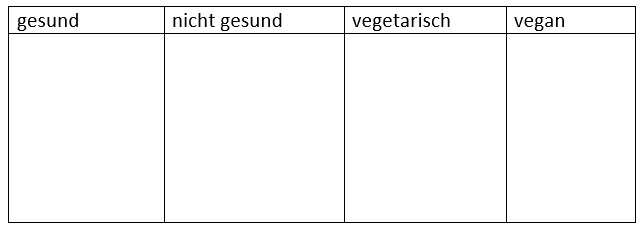
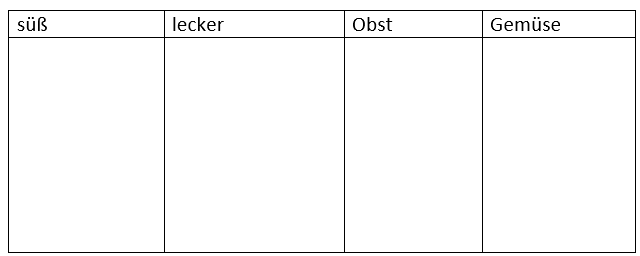
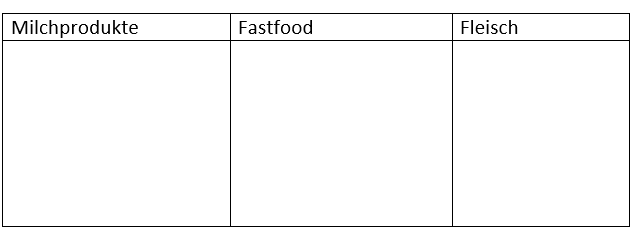
Video. Watch Easy German’s video to hear more about fruit vocabulary words.
Favorites
To express that something is your favorite, attach the prefix Lieblings– to any noun.
- Lieblingsbuch→favorite book
- Lieblingsessen→favorite food
- Lieblingsgetränk→favorite drink
- Lieblingsperson→favorite person
- Lieblingskurs→favorite class/subject
Quick Listening: Philip and Michelle from AudioLingua. Was ist sein Lieblingsessen? Was ist ihr Lieblingsessen?
KULTURECKE: Döner–a German favorite from Turkey! Watch Deutsch im Blick’s video. A Döner restaurant owner describes which foods go together with Döner. (Used with permission from The University of Texas at Austin | coerll.utexas.edu.)
Ex. G: Was ist dein Lieblingsessen? With a partner, ask each other the following questions. Answer in complete sentences. Don’t forget to put the correct ending on “mein/e” that corresponds with the gender of the word.
Beispiel: Lieblingsbuch
A: Was ist dein Lieblingsbuch?
B: Mein Lieblingsbuch ist Herr der Ringe.
- Lieblingsessen
- Lieblingsgetränk
- Lieblingsperson (Hint: Use „wer“ instead of “was”!)
- Lieblingskurs
- Lieblingsfilm
- Lieblingssport
- Lieblingsspiel
- Lieblingsland
Video. Watch Easy German’s video to hear Germans answering the question, “Was ist dein Lieblingsobst?”
Video. Favorite Food. Watch Easy German’s video to hear Germans answering the question “Was ist Ihr Lieblingsessen?”
Look through Claudia Kost’s and Crystal Sawatzky’s (University of Alberta) slides to see some typical foods eaten for lunch in Germany:
Deutsche Musik: Listen to Namika’s hit song, „Lieblingsmensch,“ (2015) to practice Lieblings-.
Ex. H: Essen Sie gern asiatisch? Ask your classmates how well they like the following types of food.
Beispiel: vietnamesisch
A: Essen Sie gern vietnamesisch?
B: Ja, ich esse gern vietnamesisch?
ODER
B: Nein, ich esse nicht gern vietnamesisch?
- italienisch
- deutsch
- türkisch
- griechisch
- mexikanisch
- indisch
- japanisch
- chinesisch
- amerikanisch
Ex. I: Typisch deutsch! Watch Easy German’s video about traditional German food and give a short description of the foods below. Use the adjectives that you have learned so far, such as those on page 12, or larger classifying categories, such as Fleisch, Gemüse, oder Obst.
Beispiel: Spätzle (plural)
→Spätzle sind Nudeln. Sie sind vegetarisch.
- Kartoffelpuffer (pl.)
- Spargel (sing.)
- Bratkartoffeln (pl.)
- Leberkäse (sing.)
- Maultaschen (pl.)
- Pfannkuchen (sing.)
- Bockwurst (sing.)
- Kartoffelsalat (sing.)
- Rouladen (pl.)
- Grünkohl (sing.)
- Erbsensuppe (sing.)
- Currywurst (sing.)
Ex. J: Was brauchen wir? What do we need to make the dishes below? Write complete sentences. ![]()
Beispiel: Wir machen Spaghetti. Was brauchen wir?
→Wir brauchen Nudeln, Tomaten und Fleisch.
- Wir machen eine Pizza. Was brauchen wir?
- Wir machen Gemüsesuppe. Was brauchen wir?
- Wir machen einen Salat. Was brauchen wir?
- Wir machen einen Obstsalat. Was brauchen wir?
- Wir machen einen Hamburger. Was brauchen wir?
- Wir machen Gulasch. Was brauchen wir?
KULTURECKE: Watch Deutsch im Blick‘s video of Andrew and Austin in a German supermarket. Was brauchen sie? (Used with permission from The University of Texas at Austin | coerll.utexas.edu.)
Ex. K: Was essen Sie? What do you eat and drink for the following meals? Answer in complete sentences.
- Was essen Sie zum Frühstück?
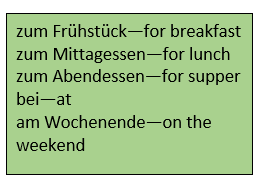
- Was trinken Sie zum Frühstück
- Was essen Sie zum Mittagessen?
- Was trinken Sie zum Mittagessen?
- Was essen Sie zum Abendessen?
- Was trinken Sie zum Abendessen?
- Was essen Sie bei McDonald’s?
- Was trinken Sie bei McDonald’s?
- Was essen Sie und trinken Sie am Wochenende?
QUICK REVIEW: Watch Deutsch im Blick‘s video of Berna talking about herself. Then answer the comprehension questions. (Used with permission from The University of Texas at Austin | coerll.utexas.edu.)
Video: Watch Easy German’s video, “Lunch Break,” in extra slow German.
EXTRA PRACTICE: Want more food words and more practice with them? The following exercises will help you with both.
- https://www.germanzone.org/essen-und-trinken-2-kategorien/.
- https://www.germanzone.org/essen-und-trinken-1/.
Ich trinke Cola und spiele Fortnite!

